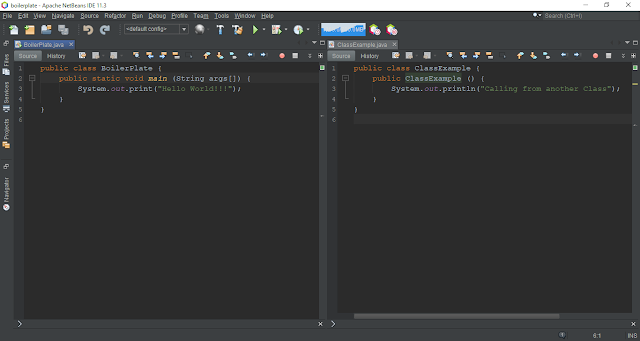So, an IDE or an Integrated Development Environment is a software application that contains many other essential tools for
developing software. All the tools included in
the IDE helps developers in many ways. Tools like code autocompletion and
syntax highlighting will increase developer's productivity and gives them
more easiness when writing codes. Cutting out an amount of time required to develop
a program or software while reducing the number of works needed to be done
manually by developers (automation). I'll be using Netbeans as an example for all the features, but other IDEs has almost the same functionality as shown in the pictures.
Key Feature of an IDE
In any case, IDE has many features
which benefit developers. I've listed out some of its key elements in the following:
I know this is somewhat obvious when an
IDE job is to develop software and of course it can let us edit our source
code. But some programming languages source files could be modified by simply using the window's notepad. But it would be tough to write code in a notepad as we need
to open each file that we want on a separate window. So, this is where an IDE
comes in handy. In an IDE we can open as many files we want without opening
each file in a separated window. Each opened file can be navigated freely by
changing the through the tabs. You can also view two or more files at the same
time by separating them into a different position in the IDE (split view) and
edit the files alongside each other.
Besides that, most IDE will have a file
manager installed alongside the IDE. It shows you the files as well as the
folders of the projects that you're working on. This lets us keep track of our
project progress easily while reducing the hassle when managing files and
folders. The file manager also enables you to create, edit, move and delete
files as well as folders.
IDE also provides programmers with
visual cues according to their programming languages. Different type of keywords has
different highlighted colour, making the code easier to read and understand.
One of the most popular features that
programmers love about when using an IDE is the ability of the IDE to
auto-complete the code by predicting what the programmer is going to type. This
saves many keystrokes that programmers need to type, therefore saving precious
time for other development areas.
Programming languages like Java and C++
source code needs to be compiled first before we can use the program. The
compilation process will need the programmer to provide a command with some
parameter (that's to be passed) required by the compiler, which requires some
amount of time to write the command. Although this could be solved by using scripts to automate the
compiling process. But IDE lets us skip this part by helping us automatically
compile our project files. We can also configure the process ourselves if we
need to add some custom option during the compilation.
Debugging
When writing a program, no programmers
can avoid writing bugs and make program errors. When a program doesn't run
correctly, IDE which has debugging tools installed will let the programmer know
about the error and possible ways to solve the error. IDEs will also provide
programmers with a guide to prevent them to unconsciously that will definitely
cause an error during the compilation process.
That's all in this article, thanks for reading. I hope you now know what an IDE is and the use of it is. If you have any comments, suggestion, or critics, feel free to leave a comment below. By the way, if you find this article helpful, remember to share it with others that might find it useful.
That's all in this article, thanks for reading. I hope you now know what an IDE is and the use of it is. If you have any comments, suggestion, or critics, feel free to leave a comment below. By the way, if you find this article helpful, remember to share it with others that might find it useful.









No comments:
Post a Comment